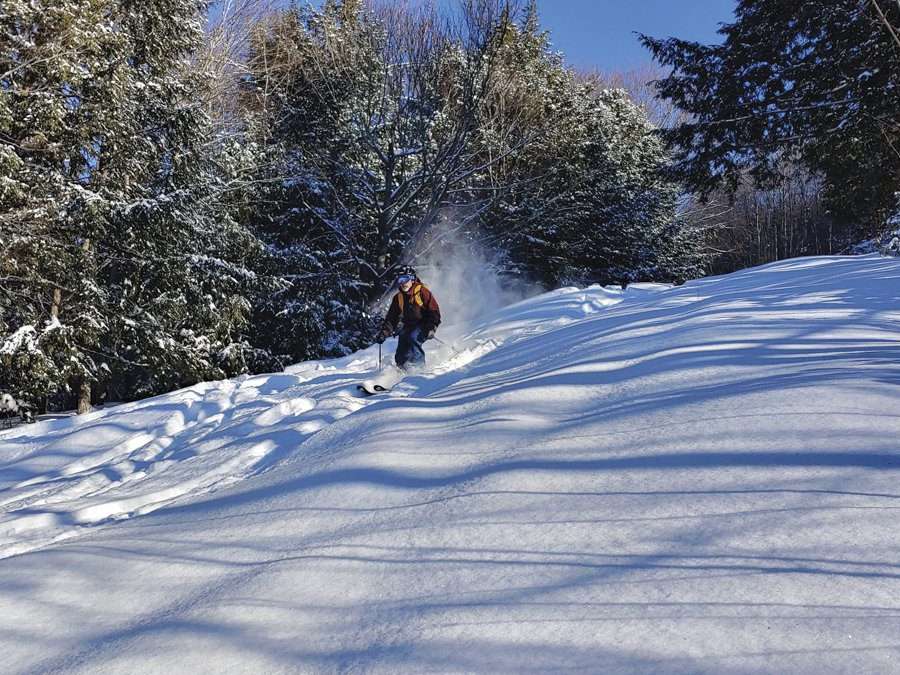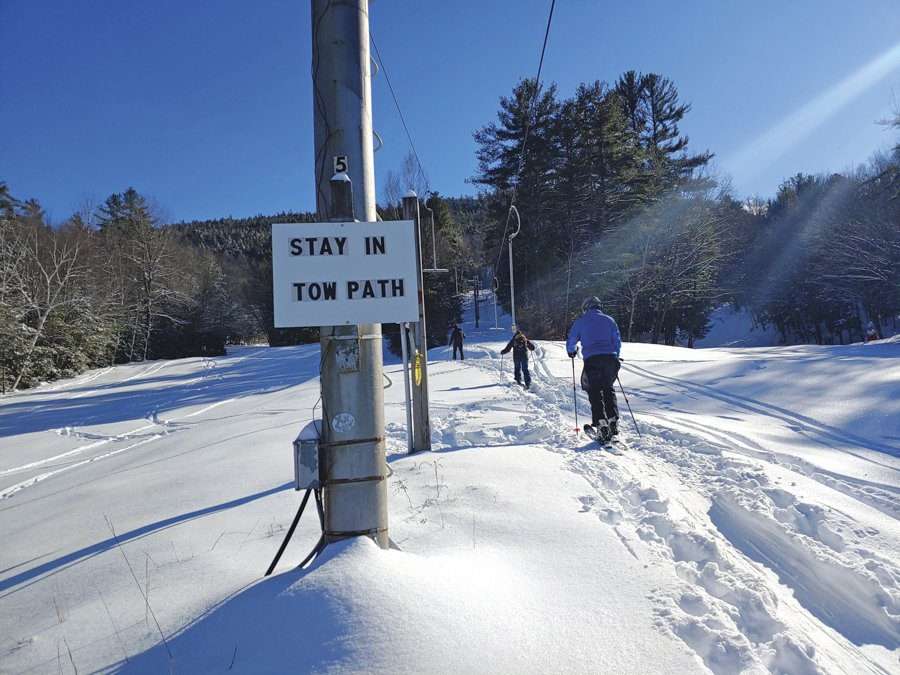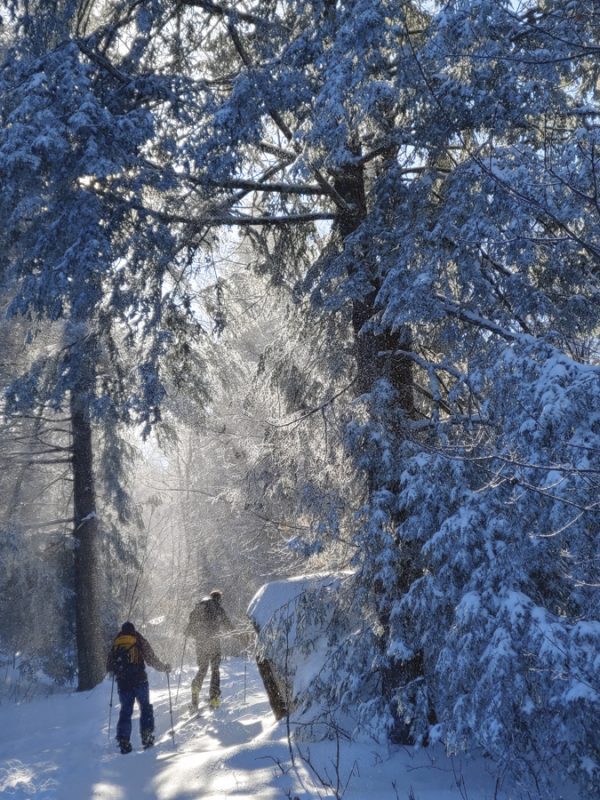
Hickory’s bright past, present and four-season future
By Alan Wechsler
We pull into the Hickory Ski Center in early February. Snow had dumped a few days earlier, and several feet of powder cover the mountain and the stilled T-bar.
That’s not a problem. We would get to the top under our own power.
In the winter of 2021-22, Hickory became one of the few ski resorts in the country to operate as a skin-up/ski-down destination. Users slip $10 into an honor box and sign a waiver (if they can get the frozen pen to work).
For Hickory, a 1,200-foot-vertical resort outside Warrensburg, it’s the latest incarnation of a history that goes back to the end of World War II.
It may become a year-round destination. Perhaps as soon as later this year, it may include mountain-biking, hiking and access to the nearby Hudson River, followed by snow sports in the winter. Other ideas include a weekend of four-wheeling, sponsored by Jeep, and a brewpub.
But for now, Hickory is in the hands of people who don’t mind earning their turns.
Joining two friends on this cold Saturday morning, I boot up and attach climbing skins to my skis that allow me to glide forward without sliding back. My backcountry ski gear is lighter than equipment used at downhill resorts, with bindings that allow a cross-country-style glide for climbing, but a locked heel for descents. Thus encumbered, we shoulder backpacks and head uphill.
When I lived in Saratoga Springs in the early 1990s, I came here nearly every Saturday. With a “buy one, get one free” coupon, a pass cost $16. A typical weekend might see a few hundred skiers. The tiny lodge had cheap burgers and a 1960s-style circular fireplace. The two Poma surface lifts, which use a pole between your legs that pulls you to the summit, launched the unwary several feet in the air when it engaged with the spinning cable. Face plants for newbies were common, and I was no exception.
The mountain has only a handful of trails that braid their way downhill. With no grooming on the upper slopes, moguls formed quickly. Even with a thick snow base, rocks were everywhere—you wouldn’t want to come here with new skis. But after a fresh dump, there was no finer place in New York to shred away the morning.

Hickory’s history
Hickory dates to 1946 when a group of WWII vets from the 10th Mountain Division began talking about opening a ski resort. Some moved to Colorado to start a little place known as Vail. Another, a draftsman from Queensbury named Hans Winbauer, his wife Fran and friends Ken and Flo Bates, reviewed snowfall patterns, sun direction and topographic maps.
They found Pine Mountain, rising above an old farm 10 minutes south of Warrensburg. After a summer of work, Hickory opened with one trail in 1946, and expanded as Winbauer and friends cleared the land and built more lifts.
“It was so popular they incorporated to raise funds and installed the first Poma lift in 1955,” said Sue Catana, the Winbauers’ daughter. Stockholders have volunteered to run the operation for decades with a few paid staffers.
“We started to struggle in the 1980s, with the economic downturn and insurance and taxes started to rise precipitously,” Catana said. “We didn’t have enough skiing capacity to pay the basic overhead costs.”
Warm winters didn’t help, but years ago there were enough robust snow years to offset the bad ones. More recently, climate change may have added to difficulties, and there were years when Hickory didn’t open at all. The mountain lacks snowmaking and installation cost is prohibitive. The mountain’s four surface lifts stopped spinning for good in 2015.
A key investor arrived. William Van Pelt, a Texas-based businessman and Saratoga Springs native, heard about Hickory during a Utah ski trip with friends from New York, and became the majority shareholder. He also purchased land adjacent to the ski center, which will allow for hiking trail expansion and other use.
But Van Pelt left the operation for locals to handle.
“I thought it would be good for the community to get it reopened,” he said. “If Hickory can get re-opened and get kids introduced to the sport, it’d be good for the town and good for skiing.”
Staging a comeback
Today, Ski Hickory Hill Inc. is made up of about 300 stockholders. Its rebirth is being managed by the Hickory Legacy Foundation, a nonprofit that is currently seeking to raise $20,000 for mobile light towers to open the lower mountain for night skiing.
Members include Joq Quintal of Oscar’s Adirondack Smokehouse in Warrensburg; Matt Maciariello of Warren Ford, who learned to ski there; Tony Stein of Camp Echo Lake (the camp used the property last summer as a place for counselors to relax); Glens Falls Attorney Stefanie DiLallo Bitter, whose family has been involved with Hickory since the 1980s; and Clint Braidwood of Saratoga Olive Oil, whose late father, John, was one of the primary forces behind the foundation.
Under the new model, skiers using the lifts on weekends will pay $300 per season plus $50 per day. Lower-mountain access, Hickory’s beginner area, with its short T-bar, will be as cheap as $7 for after-school skiing. Backcountry skiers can continue to pay a daily fee (or $100 per season) for uphill access.

Catana, 73, the mountain’s general manager, knows challenges. As a management consultant, she once coached (by phone) U.N. soldiers working with Afghan warlords during the 1980s Soviet invasion.
“My heart has always been here at Hickory,” she said. “I couldn’t see it go down the tubes without a fight.”
Operations will cost $90,000 per year. On the plus side, the ancient lifts still work fine, Catana said. Yet the lodge has been vandalized and the well pump is rusted.
More to Explore
Subscribe to print/digital issues of Adirondack Explorer,
delivered 7 times a year to your mailbox and/or inbox
Nationwide, scores of ski resorts have closed. The National Ski Areas Association reports a reduction in membership from a high of 732 resorts in 1982 to 462 in 2020.
Adrienne Saia Isaac, spokeswoman for the NSAA, said it’s rare for a closed resort to re-open. She knows of seven nationwide back in business.
“It is not cheap to run a ski area,” she said. “You’ve got to know your customer base and your community.”
Backcountry skiing could prove to be one path toward reopening. Like other outdoor activities, backcountry skiing and riding have exploded in the past few years. According to the market research company NPD Group, sales of backcountry ski and snowboard gear in America has gone from $39 million in 2016-17 to $147 million five years later.
In Vermont, the once-closed Ascutney Ski Area has been taken over by the Town of West Windsor, with a rope tow built on the lower mountain and the upper two-thirds open only for self-propelled use. Also in Vermont, organizations like the Rochester/Randolph Area Sports Trail Alliance have cultivated backcountry ski routes on National Forest land, with government permission. On snowy weekends, trails are so popular it’s often hard to find parking.
In the Adirondacks, backcountry ski routes are limited. Adventurous skiers attempt the steep High Peaks slides, when snow conditions permit, as well as trails such as Wright Peak and Mount Marcy. The Adirondack Powder Skiers Association has been working with the state for 10 years, seeking to get more dedicated trails. Founder Ron Konowitz said the group is currently building a demonstration trail on private land.
At Hickory’s summit ridge, which takes 45 minutes for us to reach, we are rewarded by a view of the nearby Hudson River, the mountains of the central Adirondacks and the distant High Peaks. The wind blows snow from the evergreen trees. It glitters in the morning light.
And we’re not alone in enjoying the place. This weekend, 92 people will visit Hickory, Catana tells me later. It’s not a huge crowd, but it’s a start.
We peel off our skins, lock in our heels, and dive skis-first into the powder.
Recreation news and information
Sign up for the “Backcountry Journal” newsletter, delivering trip ideas, info and more to your inbox every Thursday
Or click here to see all our newsletter offerings
"explorer" - Google News
May 28, 2022 at 04:43PM
https://ift.tt/CoEcew9
A ski mountain's rebirth - Adirondack Explorer
"explorer" - Google News
https://ift.tt/FCQxoGd
Bagikan Berita Ini














0 Response to "A ski mountain's rebirth - Adirondack Explorer"
Post a Comment